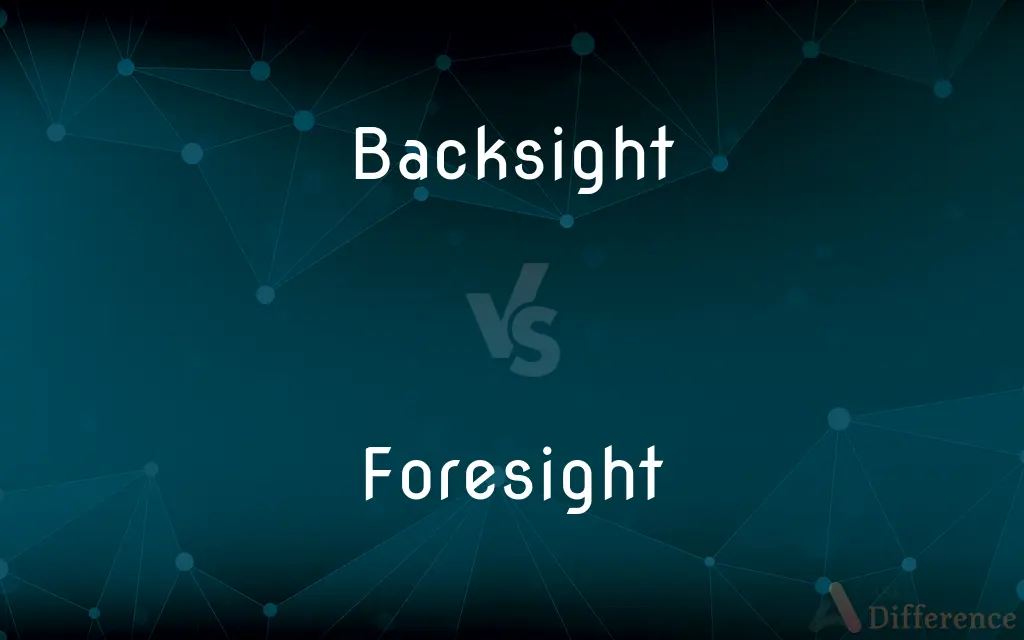Backsight vs. Foresight — What's the Difference?
By Urooj Arif & Fiza Rafique — Updated on March 7, 2024
Backsight is used in surveying to determine a reference point, while foresight is taken towards a forward point to measure elevation differences.

Difference Between Backsight and Foresight
Table of Contents
ADVERTISEMENT
Key Differences
Backsight involves taking a measurement from a survey instrument back to a previous point to establish a baseline or reference. This is crucial for ensuring accuracy in the surveying process as it helps in aligning the instrument with previously surveyed points. On the other hand, foresight is the measurement taken from the instrument towards a new point. This is typically used to calculate the difference in elevation between the surveying station and the forward point, aiding in the creation of topographic profiles and the determination of land gradients.
Backsight measurements are often the starting point in the surveying process, providing a known elevation or location that serves as a base for subsequent measurements. This ensures continuity and accuracy throughout the surveying task. Whereas foresight measurements are directed towards the progression of the survey, extending the surveyed area by establishing new points in relation to the base point provided by the backsight.
In terms of importance, both backsight and foresight are critical for the accuracy and reliability of surveying results. The backsight establishes a firm reference, ensuring that the instrument is properly aligned and calibrated. Foresight, in contrast, is essential for the advancement of the survey, allowing surveyors to extend their measurements across new terrains and assess elevation changes accurately.
The techniques used for taking backsight and foresight measurements might differ slightly depending on the equipment and the specific requirements of the survey. Backsight measurements require precision to maintain the accuracy of the survey’s reference point. Foresight measurements, while also requiring precision, focus more on extending the survey’s reach and accurately capturing new data points.
While both backsight and foresight are integral to the surveying process, their roles complement each other in achieving the overall objective of accurately measuring and mapping the land. Backsight ensures that past measurements are accurately integrated into the survey, while foresight allows for the exploration and documentation of new areas, together ensuring comprehensive survey coverage.
ADVERTISEMENT
Comparison Chart
Purpose
Establishes a reference point
Measures elevation difference to a forward point
Direction
Towards a known previous point
Towards a new forward point
Role in Surveying
Ensures accuracy and alignment
Extends the survey and measures new points
Importance
Critical for continuity and precision
Essential for survey progression and elevation assessment
Measurement Focus
Reference alignment and calibration
Elevation changes and new data acquisition
Compare with Definitions
Backsight
Used to establish a reference in surveying.
Backsight readings are crucial for accurate survey baselines.
Foresight
A forward measurement in surveying to establish elevation.
The foresight was taken to determine the hill’s slope.
Backsight
Provides a baseline for forward measurements.
The survey team used a backsight before proceeding with new measurements.
Foresight
Measures elevation differences towards new points.
To calculate the gradient, a foresight to the next stake was necessary.
Backsight
Integral for survey accuracy and precision.
Backsight checks are performed to prevent errors in elevation data.
Foresight
Progresses the survey by extending measurements.
Foresight readings help map out uncharted territories.
Backsight
A survey measurement looking back to a known point.
The surveyor took a backsight to ensure the theodolite was properly aligned.
Foresight
Essential for topographic and gradient surveys.
Foresight data is critical for accurate topographic mapping.
Backsight
Ensures instrument alignment with past points.
Regular backsights help maintain the accuracy of the land survey.
Foresight
Captures new data points for survey extension.
Each foresight added valuable information to the overall survey.
Backsight
The sight of a rifle or other weapon that is nearer the eye of the person aiming.
Foresight
The ability to predict what will happen or be needed in the future
He had the foresight to check that his escape route was clear
Backsight
A sight or reading taken backwards or towards the point of starting.
Foresight
The front sight of a gun.
Backsight
The rear sight of a firearm.
Foresight
A sight taken forwards.
Backsight
(surveying) A measurement or reading taken back towards a point of known elevation, used to calculate the height of the surveying instrument (theodolite, transit, total station).
Foresight
The ability or action of imagining or anticipating what might happen in the future.
Backsight
(surveying) A measurement of a previously shot point, used to set the angle to zero when occupying a new position.
Foresight
Care in providing for the future
Spending all of your money at once shows little foresight.
Backsight
(surveying) To shoot a backsight.
Foresight
The ability to foresee or prepare wisely for the future.
Having the foresight to prepare an evacuation plan may have saved their lives.
Foresight
The front sight on a rifle or similar weapon
Foresight
(surveying) a bearing taken forwards towards a new object
Foresight
The act or the power of foreseeing; prescience; foreknowledge.
Foresight
Action in reference to the future; provident care; prudence; wise forethought.
This seems an unseasonable foresight.
A random expense, without plan or foresight.
Foresight
Any sight or reading of the leveling staff, except the backsight; any sight or bearing taken by a compass or theodolite in a forward direction.
Foresight
Providence by virtue of planning prudently for the future
Foresight
Seeing ahead; knowing in advance; foreseeing
Common Curiosities
Why are both backsight and foresight important in surveying?
They are essential for ensuring the accuracy, precision, and extension of surveying tasks, with backsight providing a reference and foresight measuring new data.
How do backsight and foresight measurements differ?
Backsight is directed towards a known point for reference, while foresight extends the survey by measuring towards new points.
Can a survey be conducted using only backsight or foresight?
Both are necessary for a comprehensive survey, as backsight establishes accuracy and foresight extends the survey area.
What is backsight in surveying?
Backsight is a measurement taken from a survey instrument back to a known reference point, used to ensure accuracy and alignment.
What is foresight in surveying?
Foresight is a measurement taken from the survey instrument towards a new forward point, mainly to determine elevation differences.
How do backsight and foresight measurements affect survey accuracy?
Accurate backsight and foresight measurements are fundamental to achieving a high level of precision in survey results, influencing the reliability of land assessments.
Why is precision in backsight and foresight measurements crucial?
Precision ensures that the survey accurately reflects the terrain, which is essential for planning, construction, and research purposes.
How does backsight ensure accuracy in surveying?
By referencing a known point, it ensures the survey instrument is aligned and calibrated for precise measurements.
Can backsight and foresight measurements be taken with the same instrument?
Yes, surveying instruments can be used for both types of measurements, depending on the surveyor's needs.
Can errors in backsight or foresight measurements be corrected?
Yes, errors can be corrected by recalibrating the instrument and taking additional measurements, emphasizing the importance of routine accuracy checks.
Is specialized equipment required for backsight and foresight measurements?
Yes, surveying instruments like theodolites or total stations are used to take these measurements accurately.
What is the primary difference in the purpose of backsight and foresight?
The primary difference lies in their purpose: backsight establishes a reference, while foresight is used for measuring elevation differences towards new points.
How do surveyors use backsight and foresight in the field?
Surveyors alternate between backsight and foresight measurements to align their instruments accurately and extend the survey area progressively.
What role does foresight play in determining land elevation?
Foresight measurements are crucial for assessing elevation differences and mapping terrain accurately.
How do backsight and foresight contribute to topographic surveys?
They are integral in creating accurate topographic maps, with backsight providing reference points and foresight detailing elevation changes.
Share Your Discovery

Previous Comparison
Derv vs. Diesel
Next Comparison
Intaglio vs. GravureAuthor Spotlight
Written by
Urooj ArifUrooj is a skilled content writer at Ask Difference, known for her exceptional ability to simplify complex topics into engaging and informative content. With a passion for research and a flair for clear, concise writing, she consistently delivers articles that resonate with our diverse audience.
Co-written by
Fiza RafiqueFiza Rafique is a skilled content writer at AskDifference.com, where she meticulously refines and enhances written pieces. Drawing from her vast editorial expertise, Fiza ensures clarity, accuracy, and precision in every article. Passionate about language, she continually seeks to elevate the quality of content for readers worldwide.














































